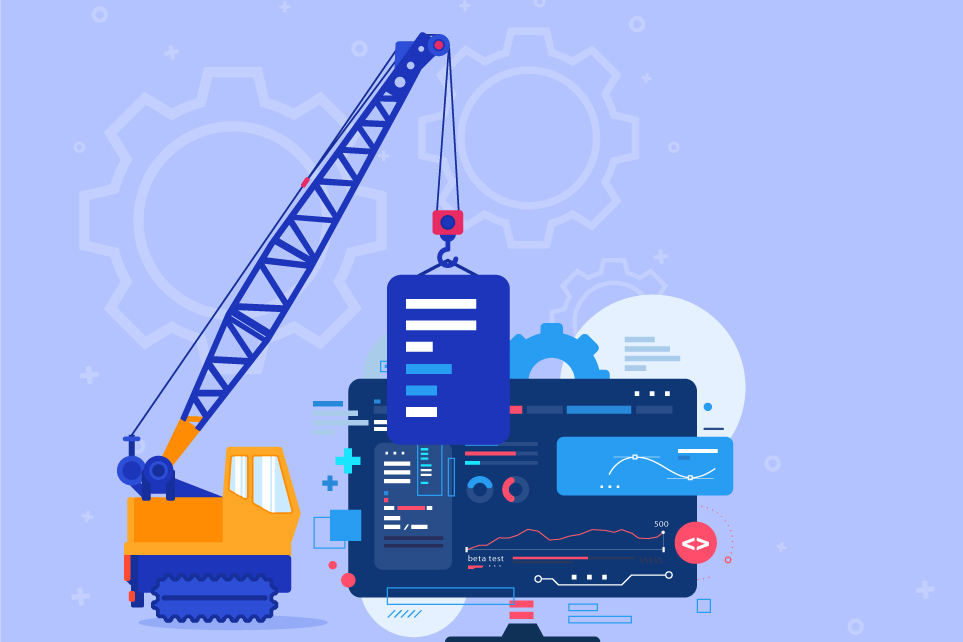The demand for software and mobile application development is growing at an exponential rate. According to Gartner, the market demand for them will increase at least five times in 2021. Moreover, traditional software or mobile app development is a time consuming and an expensive process with enormous backlogs and it becomes all the more challenging for small businesses.
Before we take a look at how low-code is giving a boost to software and mobile app development let us understand what it is actually.
Low-code is a software development approach that requires little to no coding in order to build applications and processes. A low-code development platform uses visual interfaces with simple logic and drag-and-drop features instead of extensive coding languages. These intuitive tools allow users with no formal knowledge of coding or software development to create applications for many purposes like mobile apps and business apps.
It is believed that in the near future, at least 50 percent of all new business applications will be created with high productivity toolsets like the low-code platform.
Now, let’s take a look at some of the salient features of low-code platforms which are proving to be game changers for software and mobile app development
Visual Modelling Tools
Creating apps using visual methods and models is faster than developing using code. Powered with visual modelling capabilities, low-code platforms use built-in components to represent any information in a form that is readable to anyone – from regular business users with no tech skills to professional developers.
Out-of-the-box Functionality
Leading low-code systems provide OOTB (out-of-the-box) functionality, which eliminates the need to build core modules for apps from scratch. For example, some low-code platforms include modules for data management or modules for customer facing apps, such as service management or sales processes management.
Drag and Drop Interface
Every established low-code platform has drag-and-drop abilities. It is one of the most useful and important features that enables an easy development process. Both citizen developers and professional developers benefit from the convenience drag-and-drop features provide during the creation of applications.
Reusability
One major aspect of low-code development’s OOTB functionality is the usage of pre-configured modules and functionality for apps. These modules have common core functions needed for several apps, and they can be reused to develop different solutions more quickly. It’s essential that a low-code platform allows users to reuse prebuilt or newly-developed modules, plug-ins, and entire applications to develop necessary apps faster.
Cross Platform Accessibility
Multi-device compatibility is a useful feature of low-code platforms. In addition to the ability to use the low-code platform on any device running major operational systems, its cross-platform compatibility allows users to build apps that can also run on all core platforms and devices.
Security
No matter how functional and user-friendly a low-code tool is, if it’s not secure, it is not a sufficient solution. Make sure that your low-code development platform offers proper security to protect the apps you are building and the platform as a whole before you start using it.
Scalability
Low-code systems should be scalable. It should be able to build new apps that can handle an increase in users as your business grows, whether that be twenty employees or a thousand.
Reporting and Monitoring
Apps developed using low-code can monitor workflows and processes to keep track of their effectiveness. They can also track the performance of other apps, and are useful for analysis purposes.
Application Lifecycle Management
Low-code tools simplify and streamline several stages in the software development lifecycle, such as debugging, testing, and deployment. They give users access to information about the apps created and their development and give them the ability to revert to previous versions if needed for better application lifecycle management.
Cost-effectiveness
The development tools for low-code apps are designed for the internal teams. Companies don’t need to increase the cost by hiring an external app development team. In addition, the updates can be performed by the internal team.
Limitations
Despite having some big advantages, low-code framework also comes with limitations. Sometimes, low-code framework creates challenges to work in a unique production line. Low-code tools can be a powerful asset during the POC and some UI / UX problems can be simplified to run an app faster. However, there is still a significant need for developing skills to customize the project, create backend APIs and manage infrastructure deployment.
The future of low-code
As these platforms develop alongside other technologies, builders of low-code platforms must connect their platforms to create more data sources. Technologies like the Internet of Things sensors, artificial intelligence, and blockchain can provide even more opportunities for low-code builders which will open up doors for more use cases and further development of the technology
Conclusion
Low-code platforms can help organizations to overcome the lack of coding skills and improve collaboration within the development team. It also helps the end users to achieve better business outcomes more quickly. Low-code platforms increase the effectiveness of cloud-ready applications that are large, secure, and fully integrated. Many organizations that are experienced in low-code development are expanding their development teams to meet the growing demand. They execute mission-critical company applications.
We at AppleTech have embraced this platform and are primed to create custom software and mobile apps based on it. Reach out to us today to see your concept turn into application.

